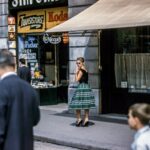Game of Thrones, the HBO series adapted from George R.R. Martin’s A Song of Ice and Fire novels, features costume design heavily influenced by medieval fashion. The show’s costumes, including elaborate gowns, cloaks, and armor, contribute significantly to its visual appeal and world-building.
The medieval period, spanning from the 5th to the 15th century, was characterized by social and political upheaval. Game of Thrones reflects this historical context through costumes that represent societal hierarchies, power dynamics, and alliances. The attire of characters, from noblewomen’s opulent gowns to warriors’ rugged armor, visually communicates their social status and political roles.
Medieval fashion influences in Game of Thrones are further evident in the use of rich fabrics, intricate embroidery, and ornate accessories. These elements not only enhance the visual appeal of the costumes but also convey characters’ wealth and status. The incorporation of historically accurate details and references in the costume design helps to ground the fictional world of Westeros in a sense of authenticity, enhancing the viewer’s immersive experience.
Key Takeaways
- Medieval fashion heavily influenced the costume design in Game of Thrones, with elements such as layered garments, fur, and leather being prominent.
- The iconic costumes of Game of Thrones characters, such as Daenerys Targaryen’s dragon-themed attire and Cersei Lannister’s regal gowns, have become synonymous with the show’s visual identity.
- The costumes in Game of Thrones are rich in symbolism, with colors, patterns, and accessories often reflecting the characters’ personalities, allegiances, and story arcs.
- The fashion in Game of Thrones evolved throughout the seasons, with characters’ costumes reflecting their changing circumstances and power dynamics.
- The intricate details and techniques used in Game of Thrones costumes, including embroidery, armor, and custom-dyed fabrics, contributed to the authenticity and visual impact of the show.
- Game of Thrones fashion has inspired real-life fashion trends, with designers and brands drawing inspiration from the show’s medieval aesthetic and iconic character looks.
- The impact of Game of Thrones fashion on pop culture and cosplay is significant, with fans recreating and interpreting the show’s costumes at events, conventions, and themed gatherings.
Uncovering the Iconic Costumes of Game of Thrones Characters
Regal Elegance: Cersei Lannister’s Opulent Gowns
Cersei Lannister, one of the show’s most complex and compelling characters, is known for her opulent and regal gowns. Designed to convey her wealth and power, Cersei’s costumes are often adorned with intricate embroidery, luxurious fabrics, and ornate accessories. The use of rich colors such as deep reds and golds further emphasizes her status as a member of the ruling class.
Rugged Practicality: Jon Snow’s Fur Cloak and Leather Armor
In contrast, Jon Snow’s costume reflects his humble origins and rugged lifestyle. His signature fur cloak and leather armor are practical and utilitarian, reflecting his role as a member of the Night’s Watch and later as a leader in the battle against the White Walkers.
Dragon Queen: Daenerys Targaryen’s Iconic Blue Dress
Another iconic costume from Game of Thrones is Daenerys Targaryen’s blue dress, which she wears during her time in Meereen. The dress features a distinctive asymmetrical neckline and is adorned with intricate dragon-themed embroidery, symbolizing her connection to her Targaryen heritage. The costume reflects Daenerys’ evolution from a vulnerable exiled princess to a powerful ruler, and serves as a visual representation of her journey throughout the series.
The Symbolism Behind the Costumes in Game of Thrones

The costumes in Game of Thrones are not just visually stunning; they also carry deep symbolism that adds layers of meaning to the characters and their storylines. From colors and fabrics to accessories and embroidery, every detail in the costumes is carefully chosen to convey specific themes and messages. Let’s explore some of the symbolism behind the costumes in Game of Thrones.
One of the most prominent symbols in Game of Thrones is the use of color. For example, red is often associated with power, passion, and danger, and is frequently used in the costumes of characters such as Cersei Lannister and Melisandre. The color blue, on the other hand, is often associated with loyalty, trust, and stability, and is frequently used in the costumes of characters such as Jon Snow and Daenerys Targaryen.
These color choices help to convey the personalities and motivations of the characters, as well as foreshadowing their fates. In addition to color symbolism, the use of fabrics and textures also carries meaning in Game of Thrones costumes. For example, rich velvets and silks are often used to convey wealth and status, while rough furs and leathers are used to convey ruggedness and practicality.
These fabric choices help to reinforce the social hierarchies and power dynamics at play in the show’s fictional world. Furthermore, the use of embroidery and accessories in Game of Thrones costumes also carries symbolic meaning. For example, dragon-themed embroidery is frequently used in Daenerys Targaryen’s costumes to symbolize her connection to her Targaryen heritage and her quest for power.
Similarly, symbols such as lions and roses are used in the costumes of characters such as Cersei Lannister and Margaery Tyrell to convey their family allegiances and political ambitions.
The Evolution of Fashion in Game of Thrones Throughout the Seasons
| Season | Main Characters | Fashion Trends | Key Elements |
|---|---|---|---|
| Season 1 | Daenerys Targaryen, Cersei Lannister, Jon Snow | Medieval-inspired dresses, fur cloaks, armor | House sigils, leather details, earthy tones |
| Season 3 | Margaery Tyrell, Sansa Stark, Jaime Lannister | Intricate embroidery, flowing gowns, military uniforms | Floral motifs, rich fabrics, structured silhouettes |
| Season 5 | Cersei Lannister, Arya Stark, Brienne of Tarth | Dark colors, distressed fabrics, rugged armor | Symbolic jewelry, weathered textures, layered looks |
Over its eight-season run, Game of Thrones has showcased a wide range of fashion styles that have evolved alongside its characters and storylines. From lavish gowns to rugged armor, the costumes in Game of Thrones have undergone significant changes that reflect the characters’ journeys and the shifting political landscape of Westeros. Let’s take a closer look at how fashion has evolved throughout the seasons of Game of Thrones.
In the early seasons of Game of Thrones, the costumes were characterized by their historical accuracy and attention to detail. The costumes reflected the feudal society of Westeros, with noblewomen wearing elaborate gowns adorned with intricate embroidery and noble men wearing ornate armor and cloaks. As the series progressed, however, the fashion evolved to reflect the changing fortunes of its characters.
For example, Sansa Stark’s costumes transitioned from innocent pastel colors to darker, more somber tones as she endured hardship and loss. The evolution of fashion in Game of Thrones is also evident in its portrayal of different regions and cultures within Westeros. The costumes worn by characters from Dorne, for example, feature vibrant colors and lightweight fabrics that reflect the region’s hot climate and exotic culture.
Similarly, the costumes worn by characters from the Iron Islands are rugged and utilitarian, reflecting their seafaring way of life. These regional differences in fashion help to create a richly textured world that feels authentic and immersive for viewers.
The Intricate Details and Techniques Used in Game of Thrones Costumes
The costumes in Game of Thrones are renowned for their intricate details and exquisite craftsmanship, which bring the show’s fictional world to life with stunning visual authenticity. From hand-embroidered motifs to custom-made armor, every costume in Game of Thrones is a work of art that showcases a wide range of techniques and materials. One of the most striking aspects of Game of Thrones costumes is their use of hand-embroidery.
Many of the costumes feature elaborate embroidery that is meticulously hand-stitched by skilled artisans. This attention to detail adds depth and texture to the costumes, as well as conveying symbolic meaning through carefully chosen motifs and patterns. For example, Daenerys Targaryen’s iconic dragon-themed embroidery serves as a visual representation of her Targaryen heritage and her quest for power.
In addition to hand-embroidery, Game of Thrones costumes also feature custom-made armor that is crafted using traditional metalworking techniques. The armor worn by characters such as Jaime Lannister and Brienne of Tarth is not only functional but also visually striking, with intricate detailing that reflects the characters’ personalities and fighting styles. The use of metalworking techniques adds an extra layer of authenticity to the costumes, as well as showcasing the skill and craftsmanship of the costume designers.
Furthermore, Game of Thrones costumes also feature a wide range of materials that are carefully chosen to convey specific themes and messages. Luxurious fabrics such as silk and velvet are used to convey wealth and status, while rougher textures such as fur and leather are used to convey ruggedness and practicality. These material choices add depth and richness to the costumes, as well as enhancing their visual impact on screen.
How Game of Thrones Fashion Has Inspired Real-Life Fashion Trends

From Westeros to the Runway
The impact of Game of Thrones fashion extends beyond the confines of Westeros, influencing real-life fashion trends around the world. From red carpet events to high fashion runways, elements of Game of Thrones costumes have been reinterpreted and incorporated into contemporary fashion designs, showcasing the enduring influence of the show’s iconic style. One notable example of Game of Thrones fashion inspiring real-life trends is the resurgence of medieval-inspired silhouettes and details in high fashion collections.
Medieval Revival in High Fashion
Designers such as Alexander McQueen and Valentino have drawn inspiration from Game of Thrones’ opulent gowns and armor-like structures to create dramatic runway looks that evoke a sense of fantasy and grandeur. Elements such as corsetry, chainmail accents, and rich brocades have become recurring motifs in high fashion collections, reflecting a renewed interest in medieval aesthetics.
Red Carpet and Bridal Wear Inspiration
In addition to high fashion, Game of Thrones fashion has also made an impact on red carpet style, with celebrities incorporating elements of Westerosi fashion into their own looks. From regal capes to statement jewelry inspired by dragon motifs, red carpet appearances have showcased a range of Game of Thrones-inspired fashion choices that pay homage to the show’s iconic style. Furthermore, Game of Thrones fashion has also influenced bridal wear trends, with many brides drawing inspiration from the show’s romanticized medieval aesthetic for their wedding gowns. Elements such as flowing sleeves, intricate embroidery, and ethereal silhouettes have become popular choices for brides seeking a touch of fantasy-inspired romance on their special day.
The Impact of Game of Thrones Fashion on Pop Culture and Cosplay
Game of Thrones fashion has had a significant impact on pop culture and cosplay communities around the world, inspiring fans to recreate their favorite characters’ iconic looks with meticulous attention to detail. From elaborate handmade costumes to fan conventions dedicated to celebrating Westerosi style, Game of Thrones fashion has become a central part of fan culture. Cosplay enthusiasts have embraced Game of Thrones fashion with enthusiasm, creating stunning replicas of characters’ costumes that showcase their dedication to capturing every intricate detail.
From Daenerys Targaryen’s flowing blue dress to Jon Snow’s rugged fur cloak, cosplayers have brought Westerosi fashion to life with impressive skill and creativity. In addition to cosplay, Game of Thrones fashion has also become a popular theme for fan conventions and events dedicated to celebrating all things Westeros. These events often feature costume contests, where fans can showcase their own interpretations of their favorite characters’ looks while competing for prizes and recognition within the community.
Furthermore, Game of Thrones fashion has inspired a wide range of merchandise and licensed products that allow fans to incorporate elements of Westerosi style into their everyday lives. From jewelry inspired by dragon motifs to clothing lines featuring medieval-inspired silhouettes, fans have embraced Game of Thrones fashion as a way to express their love for the show while adding a touch of fantasy-inspired flair to their wardrobes. In conclusion, Game of Thrones has left an indelible mark on popular culture through its iconic costume design that draws heavily from medieval fashion.
The influence can be seen through its intricate details that reflect symbolism behind each character’s costume design throughout each season. This has inspired real-life fashion trends through its impact on high fashion runways as well as red carpet events where celebrities have incorporated elements from Westerosi fashion into their own looks. Furthermore it has had an impact on pop culture through cosplay communities around the world who have embraced Westerosi fashion with enthusiasm creating stunning replicas showcasing their dedication capturing every intricate detail from their favorite characters’ looks while competing for prizes within their community.
If you’re a fan of Game of Thrones fashion, you’ll love this article on Extra Quirky that explores the iconic looks from the show and how they were created. From the intricate costumes of the noble families to the rugged attire of the Night’s Watch, this article delves into the craftsmanship and attention to detail that went into bringing the world of Westeros to life. Check it out here for a fascinating look at the fashion of Game of Thrones.
FAQs
What is Game of Thrones fashion?
Game of Thrones fashion refers to the clothing and costumes worn by characters in the popular television series Game of Thrones. The show is known for its elaborate and detailed costumes that reflect the different regions and cultures within the fictional world of Westeros.
Who designed the costumes for Game of Thrones?
The costumes for Game of Thrones were designed by Michele Clapton, who was the lead costume designer for the first five seasons of the show. She was responsible for creating the iconic looks for characters such as Daenerys Targaryen, Cersei Lannister, and Jon Snow.
What influences the Game of Thrones fashion?
The Game of Thrones fashion is influenced by a variety of historical and cultural references, as well as the specific characteristics and traits of the different regions and families within the show. The costumes often reflect the medieval and fantasy elements of the series, as well as the social status and power dynamics of the characters.
Are there any real-life fashion trends inspired by Game of Thrones?
Yes, the fashion of Game of Thrones has had a significant impact on real-life fashion trends. Elements such as medieval-inspired silhouettes, intricate embroidery, and dramatic capes have been seen on fashion runways and in designer collections, showcasing the influence of the show’s costumes on contemporary fashion.









